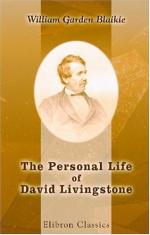At length, on the last day of January, H.M.S. “Gorgon,” with a brig in tow, hove in sight. When the “Pioneer” was seen, up went the signal from the “Gorgon”—“I have steamboat in the brig”; to which Livingstone replied—“Welcome news.” Then “Wife aboard” was signaled from the ship. “Accept my best thanks” concluded what Livingstone called “the most interesting conversation he had engaged in for many a day.” Next morning the “Pioneer” steamed out, and Dr. Livingstone found his wife “all right.” In the same ship with Mrs. Livingstone, besides Miss Mackenzie and Mrs. Burrup, the Rev. E. Hawkins and others of the Universities Mission, had come the Rev. James Stewart, of the Free Church of Scotland (now Dr. Stewart, of Lovedale, South Africa), who had been sent out by a committee of that Church, “to meet with Dr. Livingstone, and obtain, by personal observation and otherwise, the information that might be necessary to enable a committee at home to form a correct judgment as to the possibility of founding a mission in that part of Africa.” It happened that some time before Mr. Stewart had been tutor to Thomas Livingstone, while studying in Glasgow; this drew his sympathies to Livingstone and Africa, and was another link in that wonderful chain which Providence was making for the good of Africa. From Dr. Stewart’s “Recollections of Dr. Livingstone and the Zambesi” in the Sunday Magazine (November, 1874), we get the picture from the other side. First, the sad disappointment of Mrs. Livingstone on the 8th January, when no “Pioneer” was to be found, with the anxious speculations raised in its absence as to the cause. Then a frightful tornado on the way to Mozambique, and the all but miraculous escape of the brig. Then the return to the Zambesi in company with H.M.S. “Gorgon,” and on the 1st of February, in a lovely morning, the little cloud of smoke rising close to land, and afterward the white hull of a small paddle steamer making straight for the two ships outside.
“As the vessel approached,” says Dr. Stewart, “I could make out with a glass a firmly built man of about the middle height, standing on the port paddle-box, and directing the ship’s course. He was not exactly dressed as a naval officer, but he wore that gold-laced cap which has since become so well known both at home and in Africa. This was Dr. Livingstone, and I said to his wife, ‘There he is at last.’ She looked brighter at this announcement than I had seen her do any day for seven months before.”
Through the help of the men of the “Gorgon,” the sections of the “Lady Nyassa” were speedily put on board the “Pioneer,” and on the 10th February the vessel steamed off for the mouth of the Ruo, to meet the Bishop. But its progress through the river was miserable. Says Dr. Stewart:




